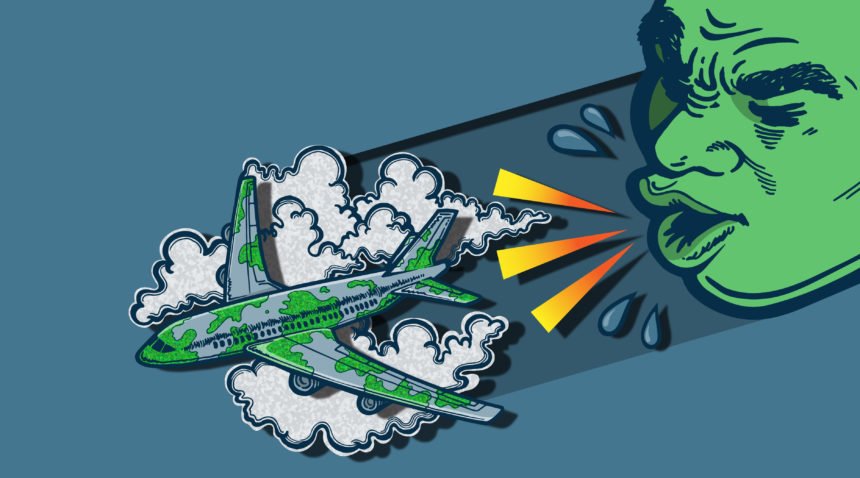You’ve stowed your carry-on in the overhead compartment, settled into your seat and are waiting for takeoff. Then you notice someone sitting near you is sniffling, sneezing and blowing his nose, and it sounds like he has a cold.
Are you at risk of catching it? If so, what can you do to reduce your risk?
To find out, we spoke with David Weber, MD, MPH, an infectious disease expert at UNC Medical Center and a frequent air traveler, about how to minimize your risk of infection during air travel.
Airborne Illnesses
“The first thing you should take note of is how close is that person to you?” Dr. Weber says. “You are at greater risk if the person is seated within two rows of you. But your risk is lower if the person is seated three or more rows away.”
Upper respiratory infections, such as the common cold and the flu, are the most common illnesses that air travelers might be exposed to while in flight. Other airborne diseases such as measles, chickenpox and tuberculosis are rare, but there have been documented cases of each in which a passenger infected another passenger during air travel, Dr. Weber says.
Several factors associated with air travel make you more susceptible to upper respiratory infections.
“Airplanes tend to have low humidity on board while in flight. This dries out the mucous membranes, and that makes people more vulnerable to upper respiratory infections,” Dr. Weber says. “In addition, the recirculated air on airplanes means less fresh air and a potentially higher concentration of viruses or bacteria in the air, and that also makes people more vulnerable.”
Typically, airplane passengers often are not able to move to a different seat while in flight. So, if you are seated close to someone who has a cold or the flu, you’ll most likely have to stay there for the duration of the flight.
Reduce Your Risk for Airborne Illness
Fortunately, there are a few things you can do to reduce your risk, Dr. Weber says. These include:
- Avoid choosing an aisle seat, where more people will walk by you.
- Avoid sitting in window seats during the winter because they may be colder and have more recycled air flow; both factors can contribute to higher infection rate. Keep your air conditioning nozzle on a low setting.
- Use disinfecting wipes or hand sanitizer to cleanse your hands.
- Use disinfecting wipes to cleanse your armrests and tray table before use.
- Bring a mask that covers your nose and mouth, and wear it if you are seated near a person who is coughing or sneezing.
Contact-Transmitted Illnesses
A second risk that air travelers can face is a contact-transmitted illness such as norovirus, which is very contagious and causes stomach pain, diarrhea, nausea and vomiting. This virus spreads easily and quickly from infected people to others and through contaminated foods and surfaces.
You don’t have to directly touch a person infected with norovirus to be at risk. You could be at risk if you touch a surface, such as the tray table at your seat, after it has been touched by an infected person.
“Even though the alcohol or other agents in most disinfecting wipes are not effective against norovirus, it’s still a good idea to cleanse your tray table because just rubbing these surfaces may physically remove the germ,” Dr. Weber says.
Airplane restrooms also can house the germs that can make you sick, he says. When someone flushes an airplane toilet without closing the lid, tiny droplets from the toilet can fly into the air and land on nearby surfaces inside the cramped space, such as the sink, the faucet handle or even the doorknob.
“For that reason, I recommend that you not touch the restroom doorknob or the restroom faucet handles with your bare hands,” Dr. Weber says. “Instead, use a paper towel or napkin.”
Foodborne Illnesses
A less common risk that air travelers face is foodborne illnesses, such as salmonella or hepatitis A virus. Norovirus also can be transmitted through contaminated food or water. These illnesses can occur when the food served in flight is not cooked thoroughly, not refrigerated properly or not prepared using appropriate sanitation guidelines.
All travelers should follow the recommendations of the Centers for Disease Control and Prevention and get vaccinated for hepatitis A if indicated, Dr. Weber says.
When You Get Off the Plane
Unfortunately, your risk of catching a respiratory virus does not end when you get off the plane. A study conducted in 2018 collected air samples from crowded areas at one airport and tested them to see if they contained any respiratory viruses.
Four of the 24 samples, or 17 percent, tested positive for known respiratory pathogens, including an influenza (flu) virus and adenovirus.
So take the same steps to avoid your risk of infection that you did on the plane, Dr. Weber says. These might include washing your hands or using a hand sanitizer, using a paper towel to touch faucet or toilet handles in the restroom, and wearing a mask.
Are you planning a trip outside the United States? Depending on where you go, you may need to get immunizations at least two weeks before your departure. Call the UNC Internal Medicine Travel Clinic at (984) 974-4462 to schedule an appointment.

